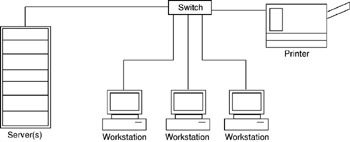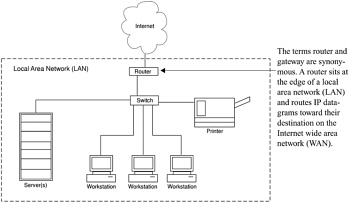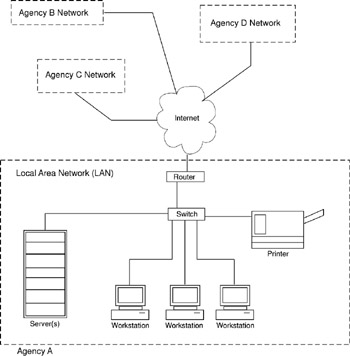Servers Clients
What Is A Computer Network?
A computer network is an interconnected collection of computing devices. A computing device, for the purposes of this rather broad definition, can be any piece of equipment that exists to participate in or support a network in some fashion. Examples of computing devices include general purpose computers, special purpose computers, routers, switches, hubs, printers, personal digital assistants (PDAs), etc.
Purpose Of A Network
Computer networks are built with a specific purpose in mind. The primary purpose of a computer network is resource sharing. A resource can be physical (i.e. a printer or a computer) or metaphysical (i.e. knowledge or data). Figure 19-1 shows a diagram for a simple computer network. This type of simple network is referred to as a Local Area Network (LAN).

Figure 19-1: A Simple Computer Network
Referring to figure 19-1 — the computing devices participating in this simple network include the workstations, the servers, the printer, and the switch. The switch facilitates network interconnection. In this configuration the workstations and servers can share the computational resources offered by each computer on the network as well as the printing services offered by the printer. Data can also be offered up for sharing on each computer as well.
The Role Of Network Protocols
A protocol is a specification of rules that govern the conduct of a particular activity. Entities that implement the protocol(s) for a given activity can participate in that activity. For example, Robert’s Rules of Order specify a set of protocols for efficiently and effectively conducting meetings. A similar analogy applies to computer networking.
Homogeneous Vs. Heterogeneous Networks
Computers participating in a computer network communicate with each other via a set of networking protocols. There are generally two types of network environments: 1) homogeneous - where all the computers are built by the same company and can talk to each other via that company’s proprietary networking protocol, or 2) heterogeneous -where the computers are built by different companies, have different operating systems, and therefore different proprietary networking protocols. An example of a homogenous network would be one comprised entirely of Apple Macintosh computers and Apple peripherals. The Macintosh computers could communicate perfectly fine with each other via AppleTalk which is an Apple networking protocol. In a perfect world, we would all use Apple Macintosh computers but the world is, alas, imperfect, and almost every network in existence is heterogeneous in nature. Apples running OS X must communicate with computers running Sun Solaris, Microsoft Windows, Linux, and a host of other hardware and operating system combinations.
The Unifying Network Protocols: TCP/IP
In today’s heterogeneous computer network environment the protocols that power the Internet — Transmission Control Protocol (TCP) and Internet Protocol (IP) — collectively referred to as TCP/IP, have emerged as the standard network protocols through which different types of computers can talk to each other. Figure 19-2 shows the local area network connected to the Internet via a router. So long as the computers on the LAN utilize an operating system that implements TCP/IP then they can access the computational and data resources made available both internally and via the Internet. (If the LAN does not utilize TCP/IP then a bridge or gateway device would be required to perform the necessary internetwork protocol translation.)

Figure 19-2: Local Area Network Connected to the Internet
What’s So Special About The Internet?
What makes the Internet so special? The answer — TCP/IP. The Internet is a vast network of computer networks. All the networks on the Internet communicate with each other via TCP/IP. The TCP/IP protocols were developed with Department of Defense (DoD) funding. What the DoD wanted was a computer and communications network that was resilient to attack. If a piece of the Internet was destroyed by a nuclear blast then data would be automatically routed through the surviving network connections. When one computer communicates with another computer via the Internet the data it sends is separated into packets and transmitted a packet at a time to the designated computer. TCP/IP provides for packet routing and guaranteed packet delivery. Because of the functionality provided by the TCP/IP protocols the Internet is considered to be a robust and reliable way to transmit and receive data. Figure 19-3 shows how the simple network of agency A can share resources with other agencies via the Internet.

Figure 19-3: The Internet — A Network of Networks Communicating via Internet Protocols
Quick Review
A computer network is an interconnected collection of computing devices. Examples of computing devices include general purpose computers, special purpose computers, routers, switches, hubs, printers, personal digital assistants (PDAs), etc. The primary purpose of a computer network is resource sharing. A resource can be physical (i.e. a printer) or metaphysical (i.e. data).
A protocol is a specification of rules that govern the conduct of a particular activity. Entities that implement the protocol(s) for a given activity can participate in that activity. Computers participating in a computer network communicate with each other via a set of networking protocols. There are generally two types of network environments: 1) homogeneous - where all the computers are built by the same company and can talk to each other via that company’s proprietary networking protocol, or 2) heterogeneous - where the computers are built by different companies, have different operating systems, and therefore different proprietary networking protocols. In today’s heterogeneous computer network environment the protocols that power the Internet — Transmission Control Protocol (TCP) and Internet Protocol (IP) — collectively referred to as TCP/IP, have emerged as the standard network protocols through which different types of computers can talk to each other.
What makes the Internet so special? The answer — TCP/IP. When one computer communicates with another computer via the Internet the data it sends is separated into packets and transmitted a packet at a time to the designated computer. TCP/IP provides for packet routing and guaranteed packet delivery. Because of the functionality provided by the TCP/IP protocols the Internet is considered to be a robust and reliable way to transmit and receive data.
EAN: 2147483647
Pages: 452